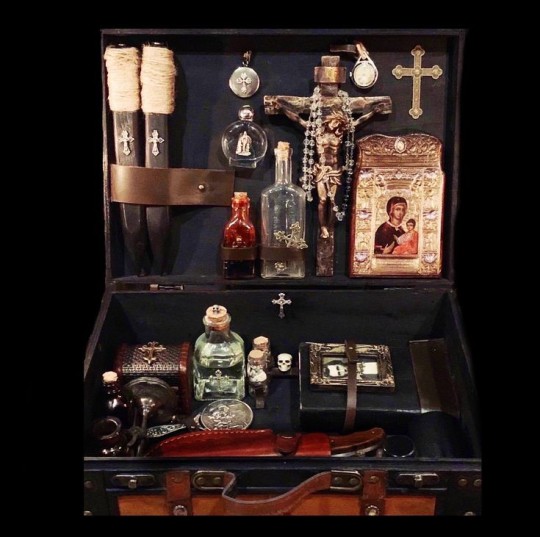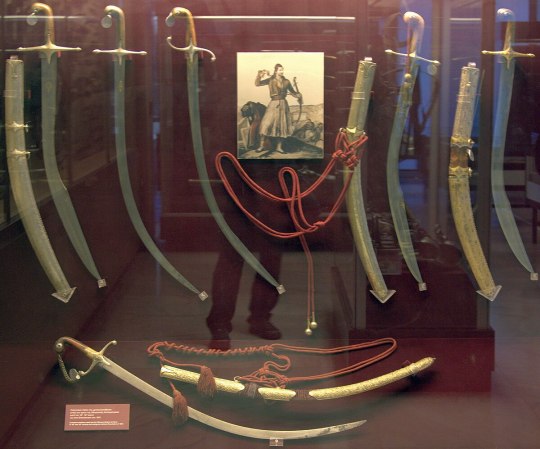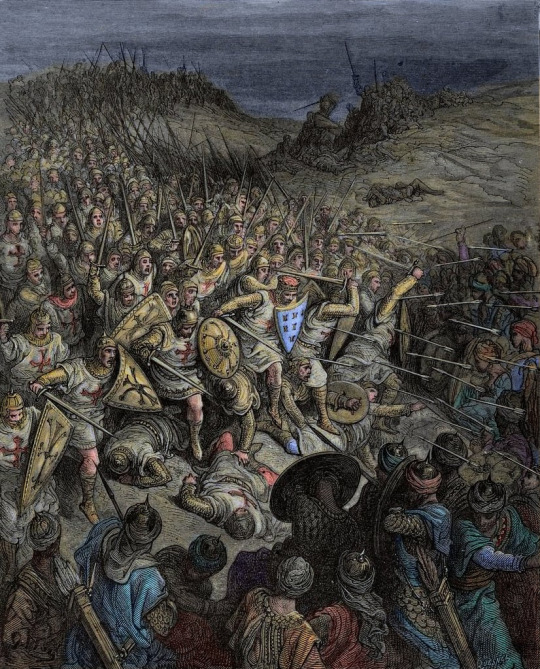#Turkish Kilij
Explore tagged Tumblr posts
Text
instagram
Universal Swords Turkish Kilij: Initial Impressions by sellsword.arts
#Kult of Athena#KultOfAthena#Turkish Kilij#Universal Swords#sellsword.arts#sword#swords#weapon#weapons#blade#blades#Kilij#Turkish Swords#Turkish Weapons#Asian Swords#Asian Weapons#Middle Eastern Swords#Middle Eastern Weapons#Middle Eastern Indian & N. African Swords#Middle Eastern Indian & N. African Weapons#Instagram#videos#sabers#1065 High Carbon Steel#Battle Ready#Turko-Mongol sabers#Asiatic stepp#Caucasus cavalrymen
3 notes
·
View notes
Text
As a vampire hunter, Darrell used to carry a big bulky case containing all his hunting tools.


When he got turned into a vampire, he couldn't stand to look or touch his own hunting case (very big holy glare: splitting headache. the holy water starts to bubble and boil when his hand hovers over it). The tools of his trade were his own weakness now, so he got rid of them.
He is, however, able to weild an Ottoman kilij or sword. Late 15th century in particular. Why? The very first vampire died by the blade of a Turkish assassin, and the only way to truly kill a vampire is to strike its heart and cut off its head.


[Various kilij on display in Germany and Greece.]
I like to think Darrell tried to track down that very sword but it was ultimately lost.
#i am a nerd#i know vlad dracula being the inspiration for the count dracula is a looong stretch made by ole brammy boy BUT#i still like to follow the fictional lore that he was the first vampire#vlad dracula and dracula being interchangeable is something you gotta respect in my house i guess 🤷🏻♀️#vampire hunter au#darrell todd#oc lore#bluecoolr.txt
16 notes
·
View notes
Text

Turkish-styled Knight "Fāris" (فارس) without the horse of course, with kilij and kalkan shield
#art#illustration#design#digital art#drawing#drawdrawdraw#character design#sword#rpg#historical#history#fantasy art#fantasy#kilij#kalkan#ottoman#turkiye#turkey#knight#faris
15 notes
·
View notes
Text

The Battle of Dorylaeum took place during the First Crusade on 1 July 1097 between the crusader forces and the Seljuk Turks, near the city of Dorylaeum in Anatolia. Though the Turkish forces of Kilij Arslan nearly destroyed the Crusader contingent of Bohemond, other Crusaders arrived just in time to reverse the course of the battle.
5 notes
·
View notes
Text
The battle of Nicaea was a siege. The illustration above probably actually represents The Battle of Dorylaeum. It took place during the First Crusade on 1 July 1097 between the crusader forces and the Seljuk Turks, near the city of Dorylaeum in Anatolia. Though the Turkish forces of Kilij Arslan nearly destroyed the Crusader contingent of Bohemond, other Crusaders arrived just in time to reverse the course of the battle.

The Battle of Nicaea in 1097 (First Crusade) by Gustave Doré
215 notes
·
View notes
Text



▪︎Miniature Sword ("Kilij").
Culture: Turkish
Date: late 18th-19th century
Period: Ottoman
Medium: blade: steel, inlaid with gold and rubies (or spinels); hilt: serpentine, gilded brass, rubies (or spinels); sheath: gilded brass, diamonds, emeralds (or beryls), rubies (or spinels), garnets
#18th century#19th century#19th century art#history#art#history of art#weapon#weaponry#sword#kilij#turkish#ottoman
377 notes
·
View notes
Text

A beautiful Kilij inlaid in gold with Quranic verse,
OaL: 36.2 in/92 cm
Ottoman Empire, 17th century, from MK Antiques.
226 notes
·
View notes
Text






Mughal period Turkish kilij blade and Indian style hilt with trade mark on blade
For sale ±91-8278902213 whatsapp chat
#shamshir#tulwar#talwar#saber#mughal#sikh#antique#wootz Steel#Mark#turkish#kilij#pala#tegha#sale#art#collector#Spotify
13 notes
·
View notes
Text
Greetings everyone.
We are manufacturers of swords daggers and armors and we make best quality gold and silver koftgari damascened products.
Follow us to get the latest updates of my products.




#swords#daggers#wootz#gold#damascene#damascus#koftgari#weapons#indian arms#mughal#turkish#ottoman#kilij#antique#19th century#dagger#museums#history
18 notes
·
View notes
Text

This custom crafted Turkish Kilij was forged by swordsmith Kılıç Osman Başkurt in Turkey and has a blade of well-tempered 6150 high carbon steel with a hardness of about 50 – 55 HRc. The guard and pommel are mild steel that has a rough equivalency to 1020 steel and the well-carved and finely polished wood grip is stabilized Turkish boxwood. The sword is matched with a wooden scabbard which is bound in blackened goat leather and completed with steel fittings.
✨ In Stock and Available to order now ✨
#Kult of Athena#KultOfAthena#Kılıç Osman Başkurt#Kilic Osman Baskurt#Early Ottoman Turkish Kilij#sword#swords#weapon#weapons#blade#blades#Kilij#Turkish Swords#Turkish Weapons#Asian Swords#Asian Weapons#Middle Eastern Swords#Middle Eastern Weapons#Middle Eastern Indian & N. African Swords#Middle Eastern Indian & N. African Weapons
5 notes
·
View notes
Text



"Kavas" military officers in full ceremonial costume, Jerusalem, 1890s
#ottoman#archaeology#anthropology#modern history#jerusalem#shamshir#kilic#kilij#ottoman empire#turkey#turkish history
122 notes
·
View notes
Video
youtube
Why the Ottoman Pala is the Ultimate Slashing Sword
Today we're going to be looking at a variant of the venerable ottoman kilij. this is a turkish pala, from around 1780. The pala was a specific subclass of kilij, and is an infantry weapon designed for performing draw cuts.
This video is an updated version of my 2017 video, with a few corrections and expansions as well as better video and image quality.
This example features a blade made out of turkish ribbon twist steel, a style of multi bar pattern welding renowned for its technical difficulty and attractive starburst patterning. It features a scarf welded iron tang.
The crossguard is made of a copper alloy, and features langets extending down towards the hilt, and into the blade. These help secure it in its scabbard. The grip is made of horn.
The history of the turkish sabre, or kilij, extends back into the 15th century, when the distinctive yalmani style of kilij formed. The term Yelman refers to the flared tip and false edge seen on these swords. Earlier examples would have a sharpened false edge, but this one does not.
One very unique feature to this infantry pala is the T shaped spine. This spine shape provides stiffness and allows for an extremely fine edge geometry. It does, however, prevent you from cutting "normally" with a large majority of the blade, as the spine causes resistance in a chop. This forces you to perform draw cuts with this blade, or to cut with the distal portion, known as the foible.
The blade also features a unique curvature, being straight in the forte, before having a slight recurve and a strong secondary curve, before transitioning into the foible.
The foible of this blade is very thin, being 1.5mm at it's thickest, and relatively broad. This makes it rather flexible, and also makes it less efficient at thrusting.
This example weighs 673 grams, and is 79cm overall with a 66cm long blade. It balances around 17cm from the guard, and feels very light and maneuverable.
This is owing to the light weight, and the curved blade which makes edge alignment feel more natural.
This is a very formidable and functional sword. The acute edge is well suited to slicing through textiles, and the light weight and maneuverability make it fast to swing and recover with. Despite being such a functional weapon, the blade is still truly beautiful, featuring a bold and tight pattern.
#sword#swords#sabre#saber#kilij#pala#ottoman#turkish#18th century#antique#antiques#ipostswords#youtube
80 notes
·
View notes
Text


Turkish kilij with silver cross guard and scabbard, gold decorated blade, 19th century
from Probus Auktioner
182 notes
·
View notes
Text
The Battle of Dorylaeum took place during the First Crusade on 1 July 1097 between the crusader forces and the Seljuk Turks, near the city of Dorylaeum in Anatolia. Though the Turkish forces of Kilij Arslan nearly destroyed the Crusader contingent of Bohemond, other Crusaders arrived just in time to reverse the course of the battle. It was primarily a cavalry against cavalry battle, unlike the infantry fight shown here, where the heavier armored crusader knights on big horses defeated the lighter Turkish archers riding smaller horses.

The Battle of Dorylaeum, 1097 (First Crusade)
45 notes
·
View notes
Photo

Haha okay. This is what I ended up keeping of my education, skills, and aptitudes for Alucard over his lifetime. The first paragraph is true and documented information as to the education of the irl Vlad Dracula.
No institutional education to speak of. He was tutored privately up until he was about 11. He was taught to be literate and multilingual. Historically, he spoke Bulgarian (most likely his mother tongue), Slavonic, what is now Romanian, Magyar, Turkish, German, Latin, and Greek. He would have learned basic math, how to ride a horse, and some basic information about foreign affairs, history, and religion. When he lived with the Turks he most likely taught geometry, chemistry, algebra, military history, how to fight in general (Hirano depicts him with a broadsword, but in reality he favored the kilij, a curved scimitar he learned to use with the Turks) and literature. Ottoman education was considered a higher standard of education compared to European schools.
After he turned, he wanted to learn about the nature of his new existence, and at the turn of the 16th century he picked up alchemical studies from his exposure to it via the Turks, which was basically the occult without being wholly rejected by the Abrahamic faiths. This opened the door to philosophy and further studies in chemistry. This was the gateway to him expand on his lesser intuitive capacity, as it allowed practical application theories (chemistry) to more conceptual theories (philosophy). He came to favor the works of Hermes Trismegistus, and found the concept of the Philosopher’s Stone an interesting concept. By the time his curiosity for alchemy had been sated, he’d decidedly settled on his own theory that the true nature of the Philosopher’s Stone was blood, and by “eating his own wings”--a metaphor for giving up his humanity and pursuit of divinity– he had incidentally transmuted his own blood into the Philospher’s Stone.
Conceptual studies weren’t all consuming; he still favored sensory (read as “practical”) skills. He expanded on his knowledge of arms and armory by learning to forge iron. Eventually he learned leatherwork and woodwork to supplement the creation of iron works. While these were means of survival or earning a living for humans, they were strictly hobbies for him, and he put them down to pick up new skills as his interests waxed and waned. He kept up with political affairs, domestic and foreign, and routinely brought in guests and tutors to keep his knowledge of the changing times up to date. When he wasn’t killing enemies of his homeland and feeding on them, he used the wealth he’d managed to abscond with and his up-to-date knowledge of the happenings of Europe to invest in commodities, political figures, and land.
Over time, he became less and less invested in the workings of the human world, and when he began keeping more to himself he picked up arts for the sake of learning something new. His favorite was architectural studies and design, and had a handful of properties built to his designs so he could move when there was cause for concern that he may be suspected for mass deaths in the local villages and encampments. Portraiture, landscapes, and architecture were subjects of drawing and painting, but when he reached a point of considerable technical skill he would drop the hobby for decades at a time. He learned to play a few instruments, including viola (and later on violin), harpsichord, and piano.
He consistently obtained books and hired the occasional tutor to teach him the remaining Romance languages and some others, as well as advancements in science, mathematics, philosophy, literature, warfare, and theology. This inevitably led to learning about the progression of Western Europe, and by the 19th century England was a significant place of secular development. Having learned Middle English long ago, he began learning modern English and English history with the goal of moving to England to expand his palette and his experiences of the human world.
He kept up with military developments throughout his entire life, and technology in general, and had long since begun learning how to use and maintain firearms. With the militarization of the Hellsing Organization in the 20th century, he got firsthand experience on modern weaponry, moreso under Arthur’s observance as opposed to Abraham who kept him on a very short leash. Despite sleeping through the 70’s and 80’s, he was quick on the uptake when Integra brought him back to the world. Integra allowed him to learn to operate vehicles, including cars, but particularly military aircraft as he made an excellent test pilot with effective indestructibility. He learned how to use phones and pagers, and developed a simplistic, if dismissive, understanding of how to operate a computer though he had little to no practical application of that understanding up until the end of the war in 1999.
Post series in the 2030’s he continued to bring himself up to speed on socio political affairs, technology, literature, sciences, and other practical matters.
26 notes
·
View notes